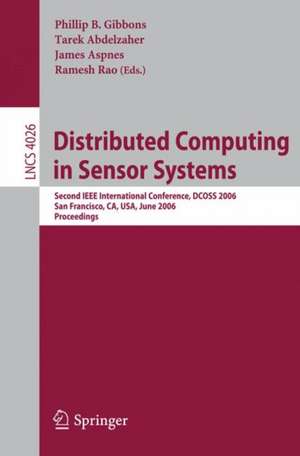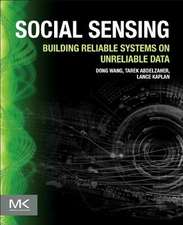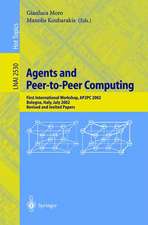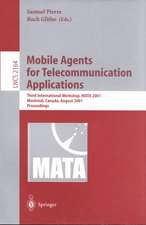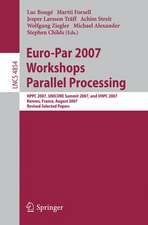Distributed Computing in Sensor Systems: Second IEEE International Conference, DCOSS 2006, San Francisco, CA, USA, June 18-20, 2006, Proceedings: Lecture Notes in Computer Science, cartea 4026
Editat de Phil Gibbons, Tarek Abdelzaher, James Aspnes, Ramesh Raoen Limba Engleză Paperback – 9 iun 2006
The 33 revised full papers presented were carefully reviewed and selected from 87 submissions. The papers focus on distributed computing issues in large-scale networked sensor systems, including systematic design techniques and tools; they cover topics such as distributed algorithms and applications, programming support and middleware, data aggregation and dissemination, security, information fusion, lifetime maximization, and localization.
Din seria Lecture Notes in Computer Science
- 20%
 Preț: 1061.55 lei
Preț: 1061.55 lei - 20%
 Preț: 307.71 lei
Preț: 307.71 lei - 20%
 Preț: 438.69 lei
Preț: 438.69 lei - 20%
 Preț: 579.30 lei
Preț: 579.30 lei -
 Preț: 410.88 lei
Preț: 410.88 lei - 17%
 Preț: 427.22 lei
Preț: 427.22 lei - 20%
 Preț: 596.46 lei
Preț: 596.46 lei - 15%
 Preț: 448.04 lei
Preț: 448.04 lei - 20%
 Preț: 353.50 lei
Preț: 353.50 lei -
 Preț: 389.49 lei
Preț: 389.49 lei - 20%
 Preț: 309.90 lei
Preț: 309.90 lei - 20%
 Preț: 645.28 lei
Preț: 645.28 lei - 20%
 Preț: 763.23 lei
Preț: 763.23 lei - 15%
 Preț: 580.46 lei
Preț: 580.46 lei - 20%
 Preț: 310.28 lei
Preț: 310.28 lei - 20%
 Preț: 655.02 lei
Preț: 655.02 lei - 20%
 Preț: 1183.14 lei
Preț: 1183.14 lei - 20%
 Preț: 340.32 lei
Preț: 340.32 lei -
 Preț: 449.57 lei
Preț: 449.57 lei - 20%
 Preț: 591.51 lei
Preț: 591.51 lei - 18%
 Preț: 938.83 lei
Preț: 938.83 lei - 20%
 Preț: 337.00 lei
Preț: 337.00 lei - 20%
 Preț: 649.50 lei
Preț: 649.50 lei - 20%
 Preț: 607.40 lei
Preț: 607.40 lei - 20%
 Preț: 1414.79 lei
Preț: 1414.79 lei - 20%
 Preț: 1024.44 lei
Preț: 1024.44 lei - 20%
 Preț: 583.40 lei
Preț: 583.40 lei - 20%
 Preț: 453.32 lei
Preț: 453.32 lei - 20%
 Preț: 575.49 lei
Preț: 575.49 lei - 20%
 Preț: 1075.26 lei
Preț: 1075.26 lei - 20%
 Preț: 585.88 lei
Preț: 585.88 lei - 20%
 Preț: 825.93 lei
Preț: 825.93 lei - 17%
 Preț: 360.20 lei
Preț: 360.20 lei - 20%
 Preț: 763.23 lei
Preț: 763.23 lei - 20%
 Preț: 340.32 lei
Preț: 340.32 lei - 20%
 Preț: 504.58 lei
Preț: 504.58 lei - 20%
 Preț: 369.13 lei
Preț: 369.13 lei - 20%
 Preț: 580.93 lei
Preț: 580.93 lei - 20%
 Preț: 343.62 lei
Preț: 343.62 lei - 20%
 Preț: 350.21 lei
Preț: 350.21 lei - 20%
 Preț: 583.40 lei
Preț: 583.40 lei - 20%
 Preț: 583.40 lei
Preț: 583.40 lei - 15%
 Preț: 438.59 lei
Preț: 438.59 lei - 20%
 Preț: 341.95 lei
Preț: 341.95 lei - 20%
 Preț: 238.01 lei
Preț: 238.01 lei - 20%
 Preț: 538.30 lei
Preț: 538.30 lei
Preț: 346.75 lei
Preț vechi: 433.44 lei
-20% Nou
Puncte Express: 520
Preț estimativ în valută:
66.36€ • 72.06$ • 55.74£
66.36€ • 72.06$ • 55.74£
Carte tipărită la comandă
Livrare economică 22 aprilie-06 mai
Preluare comenzi: 021 569.72.76
Specificații
ISBN-13: 9783540352273
ISBN-10: 3540352279
Pagini: 588
Ilustrații: XIV, 570 p.
Dimensiuni: 155 x 235 x 31 mm
Greutate: 0.81 kg
Ediția:2006
Editura: Springer Berlin, Heidelberg
Colecția Springer
Seriile Lecture Notes in Computer Science, Computer Communication Networks and Telecommunications
Locul publicării:Berlin, Heidelberg, Germany
ISBN-10: 3540352279
Pagini: 588
Ilustrații: XIV, 570 p.
Dimensiuni: 155 x 235 x 31 mm
Greutate: 0.81 kg
Ediția:2006
Editura: Springer Berlin, Heidelberg
Colecția Springer
Seriile Lecture Notes in Computer Science, Computer Communication Networks and Telecommunications
Locul publicării:Berlin, Heidelberg, Germany
Public țintă
ResearchCuprins
Evaluating Local Contributions to Global Performance in Wireless Sensor and Actuator Networks.- Roadmap Query for Sensor Network Assisted Navigation in Dynamic Environments.- Stabilizing Consensus in Mobile Networks.- When Birds Die: Making Population Protocols Fault-Tolerant.- Stochastically Consistent Caching and Dynamic Duty Cycling for Erratic Sensor Sources.- Distributed Model-Free Stochastic Optimization in Wireless Sensor Networks.- Agimone: Middleware Support for Seamless Integration of Sensor and IP Networks.- Gappa: Gossip Based Multi-channel Reprogramming for Sensor Networks.- The Virtual Pheromone Communication Primitive.- Logical Neighborhoods: A Programming Abstraction for Wireless Sensor Networks.- Y-Threads: Supporting Concurrency in Wireless Sensor Networks.- Comparative Analysis of Push-Pull Query Strategies for Wireless Sensor Networks.- Using Data Aggregation to Prevent Traffic Analysis in Wireless Sensor Networks.- Efficient and Robust Data Dissemination Using Limited Extra Network Knowledge.- Distance-Sensitive Information Brokerage in Sensor Networks.- Efficient In-Network Processing Through Local Ad-Hoc Information Coalescence.- Distributed Optimal Estimation from Relative Measurements for Localization and Time Synchronization.- GIST: Group-Independent Spanning Tree for Data Aggregation in Dense Sensor Networks.- Distributed User Access Control in Sensor Networks.- Locating Compromised Sensor Nodes Through Incremental Hashing Authentication.- COTA: A Robust Multi-hop Localization Scheme in Wireless Sensor Networks.- Contour Approximation in Sensor Networks.- A Distortion-Aware Scheduling Approach for Wireless Sensor Networks.- Optimal Placement and Selection of Camera Network Nodes for Target Localization.- An Optimal Data Propagation Algorithm for Maximizing the Lifespan of Sensor Networks.- Lifetime Maximization of Sensor Networks Under Connectivity and k-Coverage Constraints.- Network Power Scheduling for TinyOS Applications.- Approximation Algorithms for Power-Aware Scheduling of Wireless Sensor Networks with Rate and Duty-Cycle Constraints.- MobiRoute: Routing Towards a Mobile Sink for Improving Lifetime in Sensor Networks.- SenCar: An Energy Efficient Data Gathering Mechanism for Large Scale Multihop Sensor Networks.- A Distributed Linear Least Squares Method for Precise Localization with Low Complexity in Wireless Sensor Networks.- Consistency-Based On-line Localization in Sensor Networks.- The Robustness of Localization Algorithms to Signal Strength Attacks: A Comparative Study.
